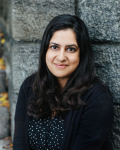One of the most vivid kitchen memories of my early childhood is of my mother hunched over a copy of Classic Indian Cooking by Julie Sahni, intently studying its pages. Released in 1980 when I was a toddler, the straightforward and technique-driven 540-page book always seemed to be at her side.
My late grandmother forbade my mother and her two sisters from entering the kitchen. She assumed that they would be resigned to a life toiling away in the kitchens of their marital homes, so she kept them out and encouraged them to pursue other interests instead. My mother tells me that her lack of culinary acumen was rare among her middle-class, English-educated peers: women were expected to know how to cook as it was a marketable skill when one was likely to be bound in an arranged marriage. When my mother immigrated to the United States shortly after she married, she hadn’t a clue in the kitchen.
It was Sahni and her cookbook that taught my mother, now an expert home chef, so much of what she knows about South Asian ingredients and cooking techniques. “It was the first Indian cookbook I found after immigrating to America,” she said. “It was so exciting. It felt familiar, when nothing else did.” She renewed Classic Indian Cooking every four weeks from the library, always on the day before it was due. “I kept it for months at a time,” she said.
The book became her steady companion in the kitchen: she referred to Sahni’s recipes for masoor daal (“Lucknow Sour Lentils,” pp. 335-337) and vegetable biryani (“Royal Vegetable and Rice Casserole,” pp. 381-382) often. She mastered Sahni’s recipe for murgh makhni (“Velvet Butter Chicken,” pp. 225-227), and it is Sahni’s version of this classic North Indian dish — chicken simmered in butter and a creamy, rich tomato sauce — that still graces my mother’s kitchen table today, nearly 40 years after she first cracked the spine of Sahni’s book.
o o o o o
I don’t know if Sahni had immigrant home cooks like my mother in mind when she wrote Classic Indian Cooking; when I spoke to Sahni this summer and asked about her intended audience at the time, she said, “the home cook in Flint, Michigan.” She hoped to offer well-tested recipes, a sort of “Indian The Joy of Cooking,” in her words.
Sahni came to authoring cookbooks, and food more generally, as an accidental second career. Raised in Kanpur, India, Sahni studied architecture at Delhi University in India. She immigrated to the United States in the late 1960s to earn a master’s degree in city planning at Columbia University in New York City and had an illustrious career as an urban designer with the New York City Planning Commission. In her spare time, she mastered French, Italian and Chinese cooking. When one of her cooking classmates asked her to teach an Indian cooking class, she designed an elaborate four-day course on a lark and invited that classmate, her cubicle colleague and her assistant to take her class.
Thus, Sahni founded the Indian Cooking School in her Brooklyn Heights kitchen in 1973. Soon after, in 1974, New York Times’ food critic Florence Fabricant profiled Sahni’s course and praised her “encyclopedic knowledge of Indian food and its history.” Fabricant went on to write: “[Sahni] has carefully designed her course to acquaint the student with the various cuisines of India. Each of the six weekly evening sessions involves both preparation and eating. An additional session is a special dinner in an Indian restaurant.” Sahni’s classes filled a void: there were no cooking classes focused on Indian cuisine in New York City at the time, and she was booked solid for years. Later, in 1978, cookbook author Patricia Wells wrote of Sahni’s classes, again in The New York Times: “Her Brooklyn kitchen is small but immaculate, and her course appears well organized and is definitely a serious class for those interested in the intricacies of the Punjabi, Kashmirian and Mougal styles of Indian cuisine.” Sahni told me that Fabricant’s and Wells’ early support and encouragement were key in the writing and publication of Classic Indian Cooking.
Classic Indian Cooking opens with nearly 100 pages on “The Principles of Indian Cooking”: a thorough primer on spices, special ingredients, equipment, technique and meal planning and service, accompanied by line drawings by Marisabina Russo (best known for her illustrations in Marcella Hazan’s More Classic Italian Cooking). The headnotes of the recipes, almost all North Indian (Mughlai, Punjabi and Kashmiri), are short on personal anecdote; the endnotes, however, offer extensive recommendations on how best to serve the dish or how to pair it with wine. Sahni introduces vegetable biryani as “the most elegant entree of all vegetarian dishes,” and describes it as “very simple to prepare.” To serve, she advises to “just add a chilled glass of Chablis,” as biryanis are complete meals unto themselves.
The book was well-received when it was published in 1980. Kirkus called it “impressive and exciting.” In the Washington Post, the late food columnist Judith Huxley wrote that Classic Indian Cooking is “exactly what a cookbook on an exotic cuisine should be … Since Sahni understands Western cooking, she draws analogies with more familiar techniques and thus makes Indian cooking a less fearful prospect. The recipes are clear, the caveats are sensible and the approach is to give the reader a comfortable idea of the results of any effort.” Mimi Sheraton, writing in the New York Times, called it one of “two exceptionally fine and much needed volumes on Oriental cooking” released that year. “[The] author has learned the hard way just where Americans are likely to become confused with the intricacies of her native cuisine,” Sheraton said. “Instructions in recipes, therefore, anticipate such problems and are models of clarity. They are also models of deliciousness and one can almost feel the warm scents of toasting spices rising in a room as one reads.”
Sahni concedes that she focused on Mughlai recipes because that is what most restaurants were serving at the time, and it was the South Asian sub-cuisine with which most people in the United States were familiar. “I wanted for readers to recreate recipes they saw in restaurants,” she said. “That’s why tandoori chicken and biryani are included. They also fitted in with the American style of cooking and eating then — with meat at the center of the meal.”
o o o o o
Sahni went on to publish a half dozen more books, including Classic Indian Vegetarian and Grain Cooking, a companion volume to Classic Indian Cooking, in 1985. She was a regular contributor to The New York Times from the late ’80s to the early ’90s. She was also the executive chef of two now-shuttered Indian restaurants in New York City — and the first Indian woman to do so. Yet, anecdotally, my peers seem to cite her contemporary, Madhur Jaffrey, as the doyenne of Indian cooking, not Sahni, who was such a fixture of my childhood.
“I suspect timing is likely the main issue: Classic Indian Cooking came out seven years after Jaffrey's An Invitation to Indian Cooking,” Mayukh Sen, a James Beard Award-winning food and culture writer and author of a forthcoming book on immigrant women who shaped food culture in America, told me. Sen is devoting a chapter to Sahni in his book. “The way that our cultural memory operates, at least in food, is so short and geared toward the new and up-and-coming that this simple fact may explain why her work hasn't quite had the stamina that Jaffrey's has had over generations.” Sen also posits that the glamour that was pervasive throughout Jaffrey’s career is absent from Sahni's public image. “Sahni was an incredibly accomplished dancer, urban planner and architect before she began her career in food, but these careers didn't become central to her image in the same way Jaffrey's career as an actress became integral to hers,” he said.
Sahni aimed to demystify and legitimize North Indian cuisine; she said as much several times in our conversation. She succeeded, as my mother will attest to, and her work continues to influence American home cooks: Classic Indian Cooking was named one of “20 Essential Books to Build Your Culinary Library” by the James Beard Foundation in 2007, and Sahni appeared on the Epicurious list of the “100 Greatest Home Cooks of All Time” a decade later, in 2017. “Lately, we've seen a few cookbooks, like Nik Sharma's Season, pushing the conversation about Indian food forward rather than positioning it as a cuisine that needs demystification,” Sen said. “Yet books like Sharma's feel like outliers in the current publishing landscape which still seems eager for an interlocutor to make Indian cuisine more ‘accessible’ for home cooks, covering the same territory Sahni did rather exhaustively many decades ago. This reality makes me feel that Sahni's books need to be rediscovered.”
o o o o o
But back to my mother: In my early 20s, I worked in cookbook publicity and marketing at HarperCollins and William Morrow — the latter is Sahni’s publisher. In a very ethically questionable move, I ordered two copies each of Classic Indian Cooking and Classic Indian Vegetarian and Grain Cooking from HarperCollins’ warehouse for personal use. I kept one set, and gave the other set to my mother.
She was thrilled. She finally had her very own copy of the book that she fell in love with as a new immigrant, even though she had far less use for it. Our copies — she and I now live together, in a multigenerational home — sit alongside other canonical American cookbooks, from Mastering the Art of French Cooking and The Taste of Country Cooking to The Bread Baker’s Apprentice and The Zuni Café Cookbook. Classic Indian Cooking is the most treasured, however. It evokes a mood, a place, a time, a guiding voice. Much of what I know about South Asian cooking I gleaned from my mother and, indirectly, Sahni continues to influence my approach to food. It’s very much a part of my past and continues to be my present.










Comments